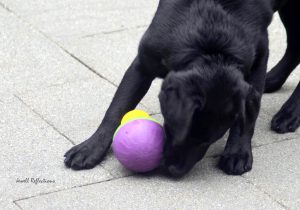BY FRAN JEWELL

Frequently, we misinterpret dog behavior. We look at dog behavior as if dogs were humans and use our own experiences to explain theirs. This is entirely normal for humans to do, but not always accurate.
One of our biggest misinterpretations has to do with anxiety. Some dogs go to great lengths to show us they are anxious.
The first sign of anxiety we do seem to notice is “separation anxiety,” if we see destruction of our home when we return to a dog left alone—although, by the time our dog begins to display this recognizable anxiety, it has become extreme. We have already missed the more subtle forms of anxiety and even thought they were something entirely different.
How wonderful it is to come home to a dog happily dancing around, wagging its tail and overflowing with excitement to see us. We understand this to be their love for us, at which point we return our love for them with just the same enthusiasm. Greeting parties feel fabulous. Unfortunately, this is the first sign of separation anxiety. While we humans think of it as love, the dog is saying to you, “Oh! I am so happy you are home. I was so afraid you were never coming back. I love the party when you get home. I hate it when you leave.”
Yes, indeed they are now happy, but we need to realize they need to be happy while we are gone. The real party should be when you leave—not when you come home—so your dog looks forward to you leaving, not that you come home. That seems very counterintuitive to we humans.
Dogs are literalists; they take things exactly as they are. When we leave home and are afraid our dog might not want to be alone, they feel our own anxiety. This is the first step to setting your dog up to be anxious. Eventually, this anxiety grows until sometimes the destruction while you are gone can become extremely costly for you and your dog.
Another form of anxiety we misinterpret is overenthusiasm for many things, or continual excitement. We humans generally think this means our dog is high-energy, which can be true, to some extent, depending on the breed. However, the vast majority of dogs with high energy are actually displaying anxiety from lack of direction, leadership or structure at home. Dogs that know that there are rules, and know there is positive reinforcement for obeying the rules, are much happier. And almost immediately they become calmer and easier to live with.
Anxiety can also be a “needy” dog that we humans misinterpret as that dog’s affection for us. Many dogs that continually need to be petted, or that always lay at your feet, can be dogs filled with anxiety and dependency. We humans, again, interpret this as their love for us when, in reality, many times it is extreme dependence or anxiety.
Recognizing dog anxiety is the first step to resolving it. Solutions come in many forms, depending on the personality traits of your individual dog. In my experience, I will say that almost all anxiety can be reduced with a tailor-made leadership program that fits you and your dog.
Fran Jewell is an Idaho Press Club award-winning columnist, IAABC-certified dog behavior consultant, NADOI-certified instructor #1096 and the owner of Positive Puppy Dog Training, LLC, in Sun Valley. For more information, visit positivepuppy.com or call (208) 578-1565.


